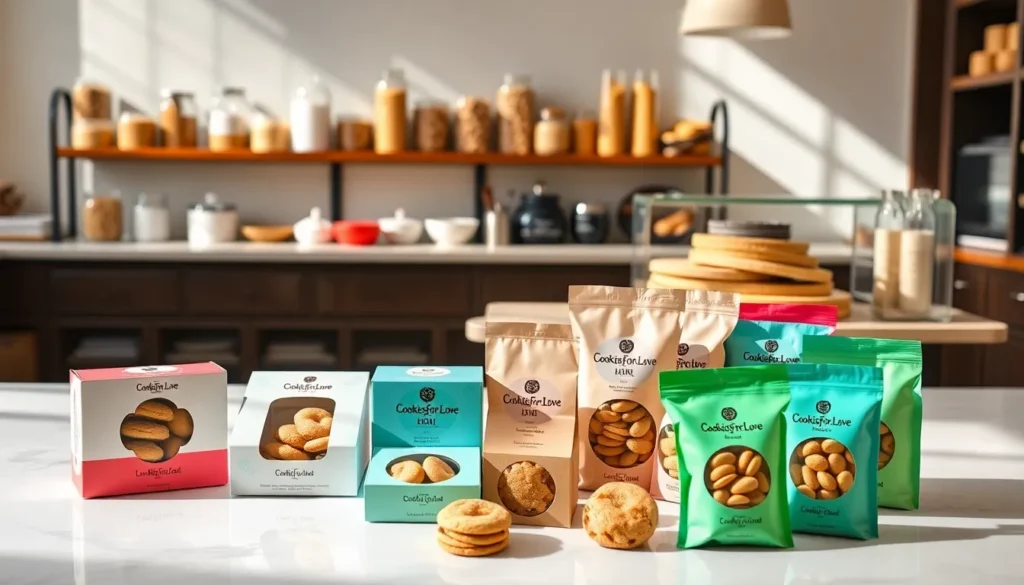In the delightful world of baked goods, your cookie packaging isn’t just a pretty face, it’s a vital player in your business strategy. Imagine this: you whip up a mouth-watering batch of cookies, only to have them presented in a plain, uninspiring box. Yikes. Not exactly the gourmet experience you were aiming for, right? Packaging sets the stage for your sweet creations and grabs attention before that first bite. In this text, we’ll explore how the right food packaging options can elevate the CookieForLove business, showcasing creativity and compliance, all while ensuring your product stays fresh and delectable. Let’s jump into the sugary depths of food packaging that can turn curious glances into delicious transactions.
Table of Contents
ToggleImportance of Food Packaging in the Bakery Industry

Food packaging serves as a crucial element in the bakery industry. It’s not just about keeping the cookies fresh, not that anyone would complain about a little extra freshness, right? Thoughtful packaging builds brand recognition and communicates quality. In an age where consumers are increasingly conscious of what they buy, eye-catching, informative packaging shapes first impressions.
Imagine a bustling bakery aisle, filled with products. What makes a shopper reach for one cookie over another? It could very well be the packaging. This includes factors like durability and sustainability, both of which impact a consumer’s decision. High-quality packaging not only preserves flavor and texture but also reflects the brand’s identity. Investors and consumers alike notice the details. Stand out in a crowded market by embracing innovative packaging options that not only attract attention but also build trust.
Eventually, effective food packaging protects the product while enhancing the perceived value. The stakes are high: after all, who wants a crumbly cookie in a flimsy wrapper? In short, good packaging can be the difference between a one-time purchase and a loyal customer.
Types of Packaging Materials
When it comes to packaging, options abound. Selecting the right material can influence everything from shelf life to consumer sentiment. Here’s a closer look at some primary types:
1. Sustainable Packaging Options
Sustainability is not just a trend, it’s a necessity. Eco-friendly packaging materials like biodegradable boxes or compostable wrappers are essential. They lure environmentally conscious consumers, representing a brand that cares. Statistics show that around 66% of consumers are willing to pay more for sustainable products. Using environmentally friendly packaging not only minimizes landfill waste but also promotes the brand’s commitment to sustainability, which can be a powerful marketing narrative.
2. Rigid Packaging Solutions
Rigid packaging, think tin boxes and sturdy cartons, provides excellent protection. Cookies are fragile, and minimizing breakage is paramount. These sturdy solutions can stand up to stacking and shipping while adding a touch of elegance to the presentation. Incorporating things like window cut-outs allows customers to see the tempting treats inside, enhancing the desirability of the product while ensuring the cookies arrive safe and sound.
3. Flexible Packaging Options
Flexible packaging like pouches or bags offers convenience and cost-effectiveness. Resealable bags are a hit. They keep cookies fresh while encouraging multiple servings. This type of packaging tends to be lightweight, reducing shipping costs. Plus, colorful prints and appealing graphics on flexible pouches can communicate the fun of your brand. Who wouldn’t want vibrant packaging that celebrates cookie joy?
Designing Your Packaging
Now that the type of packaging is sorted out, it’s time to focus on the design. Attractive packaging communicates a message and reflects the brand’s personality. Here are three major design elements to consider:
1. Branding Considerations
Branding is key. Colors, logos, and typography should align with the overall branding strategy. Cohesive visuals help consumers associate specific designs with the CookiesForLove brand, making them more likely to choose your cookies over competitors. Always ensure the brand message shines through with a clear design that resonates with your target demographic.
2. Informational Labeling
Food labels aren’t just for regulatory compliance: they educate your customers. Include essential elements like ingredients, allergen information, and expiry dates. Clear labeling fosters trust: when consumers know what’s in their food, they’re more likely to buy it. Transparency has never been so appealing. Ensure the layout is easy to read, avoiding cluttered designs that can confuse potential buyers.
3. Visual Appeal and Functionality
The visual elements of packaging should draw consumers in. Striking graphics and intriguing textures enhance visual appeal. But, don’t overlook functionality. Packaging that is easy to open and reseal enhances the customer experience. Balancing these aspects creates a package that screams quality while providing practical benefits.
Regulations and Compliance
When designing food packaging, it’s essential to keep regulations front of mind. Compliance ensures the packaged cookies not only look good but also meet safety standards. Here’s what to keep in mind:
1. Food Safety Standards
The Food and Drug Administration (FDA) establishes comprehensive standards for food packaging. They dictate materials allowed for food-safe use, labeling requirements, and hygiene protocols. Non-compliance could jeopardize public health plus to your business’s reputation. It’s crucial to stay informed and ensure your packaging meets all safety standards to create trustworthy products.
2. Environmental Regulations
With increased awareness around sustainability, businesses must also comply with environmental regulations. Many regions have restrictions on plastic use and mandates for recyclable packaging. Keep an eye on these laws to minimize penalties and align with consumers who are more likely to support earth-friendly initiatives. Being proactive about compliance enhances customer trust and protects the brand.
Strategies for Implementation
Now that the foundations are laid, it’s time to put theory into practice. Here are a couple of winning strategies for successful packaging implementation:
1. Cost-Effectiveness of Packaging Choices
While high-quality materials and designs are important, they need to be cost-effective. Strive for a balance between quality and affordability. It’s worth conducting market research and comparisons to find the best manufacturers. Bulk purchasing can reduce costs without sacrificing quality. Smart budgeting will ensure packaging stays within reasonable limits while still being appealing.
2. Testing and Feedback Processes
Feedback is invaluable. Before full-scale launches, consider performing tests on packaging designs with real consumers. Gather insights and adjust designs accordingly to align products with customer expectations. Customer feedback can reveal essential aspects to consider before making significant investments in packaging.
Future Trends in Food Packaging
As packaging evolves, staying on top of trends can provide a competitive advantage. Let’s touch on a couple of emerging trends that might shape the future of food packaging:
With the world leaning more towards sustainability, expect to see a surge in smart packaging solutions that incorporate technology. For instance, expect QR codes that link to nutritional information or sustainable sourcing stories, enhancing customer experience and engagement.
Also, personalized packaging will become more prevalent. Consumers love a tailored experience, especially when they can see their name on a cookie box. Brands embracing this trend could foster stronger emotional connections with their buyers.




